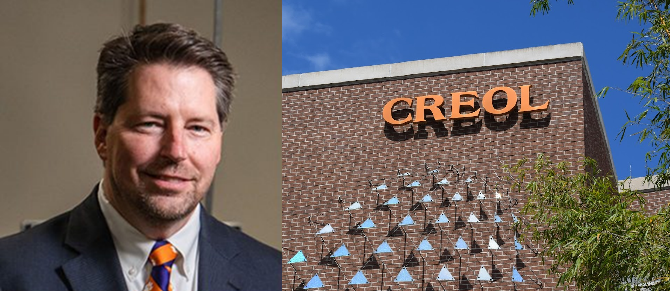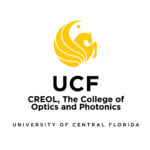A Strategy for the Future: CREOL’s Growth Continues with New Research Leadership

The way Dr. Eric Johnson ‘89MS sees it, the best is yet to come.
“I think CREOL’s right at a nexus,” Johnson says, “All the pieces are in place. Now it’s a matter of, let’s coalesce around a few things, and get people to come together from a strategic standpoint.”
As CREOL’s first Interim Associate Dean for Research, Johnson’s new position is a homecoming. His legacy at UCF began when he earned a Master’s degree in Electrical Sciences in 1989.
After earning his Ph.D. from the University of Alabama at Huntsville, Johnson’s industry career launched at a high-tech startup company, Digital Optics Corporation, where he served as Vice President of Research and Development. His success there ultimately led him back to CREOL in 2000 to be an Associate Professor for the next 8 years.
“I’ve done a lot of things since then,” Johnson says.
A few of them:
- National Science Foundation: Program Director in photonics within the Electrical, Communications and Cyber Systems (ECCS) Division
- University of North Carolina at Charlotte: Professor of Physics, Optical Science, and Electrical and Computer Engineering; Director of the Center for Optoelectronics and Optical Communications
- Clemson University: Palmetto-Net Endowed Chair in Optoelectronics and Professor of Electrical and Computer Engineering
- Career research efforts that have received more than $20 million in federal grants
Johnson’s contemplation of his next move led him back to CREOL.
“You get to the latter part of your career, and you start thinking, what else can I do?” he says. “As I keep building, what better place to do it than here?”
In Johnson’s new appointment, he will also serve as Nanophotonics Chair of the Florida Photonics Center of Excellence (FPCE), not to mention teaching classes as he continues his own research.
“There’s a lot of hats to wear,” Johnson says.
Get to know Eric Johnson and his vision for CREOL’s future:
Q: What inspired you to return to CREOL?
A: I have had the great opportunity to serve the optics and photonics community in a number of ways over the years: researcher, educator, program director, and positions within the various optical societies. Given this broad range of experiences, I believe I can help the College to move us to the next level in both research and education within the optics and photonics community.
Q: What is your vision, as CREOL’s first Interim Associate Dean for Research? What are your goals?
A: I believe CREOL has done a tremendous job through smart and hard work by a number of faculty and leaders throughout the years as UCF has grown to be a major research university. I believe the Associate Dean for Research position should help to further grow the research enterprise through strategic planning, increasing faculty collaborations throughout the university, and helping to facilitate partnerships outside of the university with both academic and industrial organizations.
We have a lot of very smart, very creative people. Now, the goal is to strategically position ourselves to build something even bigger that’s more sustainable, from a research infrastructure standpoint. Because as the University grows, there’s a very clear strategic plan that we need to map ourselves onto both in the near-term, and long-term.
Q: CREOL is growing, both in terms of the size of the faculty and their research areas. What potential do you see to continue that momentum?
A: I think CREOL can leverage the faculty, staff and the infrastructure to be competitive in larger research activities. Obviously, space photonics, medical photonics, and defense related activities are well matched with the college and the university. I would expect these areas to thrive in addition to further growth opportunities in AI and Quantum Information Science.
Q: We talked about your many hats here, which include teaching and research. How do you plan to approach those?
A: I’m very passionate about teaching. I’ve graduated about 20 PhDs over the years, and that’s probably the most satisfying part of being involved in academics. I tell students all the time, think about what you want to do – if you want to be in an academic institution, or an industrial position. There’s one fundamental difference: in industry, your product is profit. In academia, your product is pupils. So it depends on the type of person you are, and that’s the part I enjoy most – developing people and getting to watch them be successful.
As for my research group: we make wafer-based optics. We integrate those into systems for both sensing and communications, and a lot of our research has been around maritime applications, which are very harsh environments for free space communications, and probing and sensing of the environment.
Q: What first sparked your interest in optics and photonics?
A: Growing up, I wanted to be a professor. When I was an undergraduate at Purdue University, my grandmother was a department head there. I got interested in optics as a physics major, but there weren’t really many jobs in it back then. When I went to work in industry, I became interested in working in infrared systems, and later, manufacturing of optical components.
Johnson is a Fellow of Optica, SPIE, and a senior member of IEEE. He has served as a commission member for the ABET Engineering Accreditation Committee (EAC) and has served on the Board of Directors for SPIE. Johnson was also an Editor for IEEE Transactions on Electron Devices in optoelectronics, and Optica Applied Optics, and numerous other editorial and committee chair positions for IEEE, Optica and SPIE.
You can read more about Eric Johnson’s background and research here.
